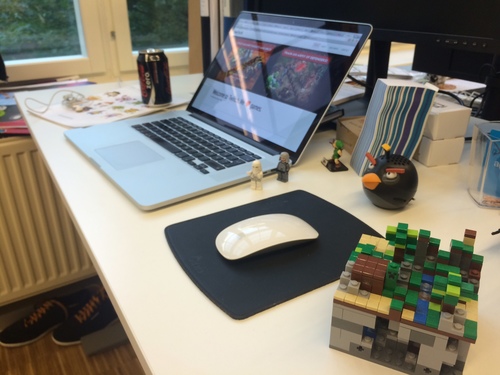Stugan, the non-profit games accelerator launched by Sweden’s top video game developers and entrepreneurs, is preparing to launch the first game to come through its inaugural program. And it’s also opened the application process for its 2016 summer program.
Twenty aspiring game developers will be selected to spend eight weeks with all expenses paid in a traditional Swedish cabin, or “Stugan” in the Swedish countryside, where they will be supported and mentored by developers from Rovio, Mojang, King, Resolution Games, Avalanche Studios, Snowprint Studios, and others, while building their games. Unlike traditional accelerator programs, all participants will keep the rights to the games they work on.

Applications will be accepted today through March 31, 2016. The application process is simple and includes a 90 second video, where applicants present themselves and their game idea, along with a short written description of themselves, the game and the goal they want to reach. Applicants can be for games developers across any platform and from anywhere in the world.
The first game to come out of Stugan (and at least three more will follow) is launching across iOS devices in mid-February. _Prism, which was created by Clint Siu, challenges players manipulate shapes and patterns to unfold sacred geometry with push and pull of cinematic design, mythology, and intuitive touch exploration. Siu attributes much of his progress on the game to his time at Stugan, where mentors and other teams helped him hone his skills and discover news ones.
Stugan manager Jana Karlikova and Tommy Palm, co-founder and CEO of Resolution Games, talk about the lessons learned from Stugan, and what’s still to come from this program, in this exclusive interview.
What separated _Prism from the other games that were created?
Jana: _Prism was one of the games that were created especially for Stugan. Clint Siu wanted to apply for Stugan so he came up with _Prism. It is a visually stunning journey through a microcosmic galaxy entirely made by a single individual. It is always very impressive when somebody masters programming, level design, sound effects and visual arts.
How are you helping to market and promote this game?
Tommy: In a way, that is outside the scope of Stugan. On the other hand, a lot of the mentors and publicity has been focused on giving the participants a platform to stand on for a launch. The interest for Clint’s game seems to be quite widespread.
What other games have potential to be released publicly from the original Stugan?
Jana: The release of the games after the scope of Stugan are not in our hands any more, but I believe that most of the games from Stugan 2015 are going to be released publicly. To name a few, Planetoid Pioneers, 20,000 Leagues Above the Clouds and Induction are other projects that are on their way to release.
What did you learn from the first Stugan that you’re applying to this summer’s program?
Jana: From the beginning there had been many challenges. From finding the perfect location through the whole application process and finding the best mentors to the whole logistics of having 23 people with different cultural backgrounds spending eight weeks together. Personally, I found that last part to be the most challenging, as I lived in the cabin with the participants. I was making sure everything ran smoothly and was coordinating the visits of mentors and journalists. We are going to apply this whole experience to Stugan 2016 and will make sure to constantly evolve the program.
How has the media attention surrounding the first program opened things up for Stugan in 2016 from a sponsorship level?
Tommy: This year sponsors knew much more about Stugan because of the high level of media interest and discussion from participants and mentors. We managed to secure more private funding this year than last year.
What impact has it had on mentors and bringing game developers in to help?
Jana: We received very positive feedback from our mentors. Each mentor spent some time having creative dialogs with the teams about their games and different aspects of game development. What we saw was that the mentors became very inspired and energized and felt that they would have liked to spend even more time with each team.
How has interest from potential participants increased even at this early stage for Stugan?
Jana: We have already received a number of emails from people who want to apply asking for when the applications will open. Based on the attention Stugan 2015 got we expect to get even more applications this time. Our last year’s participants, sponsors and mentors have become our ambassadors and are helping to spread the news.

What type of inquiries have you received from around the world in terms of interest in trying to replicate what you’re doing?
Tommy: We have heard from several countries that they are interested in doing similar things. We currently have no plans of hosting Stugan outside of Sweden.
Why do you think a program like Stugan is important for the video game industry?
Jana: The games industry has always had a tradition of sharing success and lesson learned. In a way Stugan embodies that spirit and shows how projects benefit from collaboration outside the boundaries of the company. We hope and think that it can also serve as a source of inspiration to higher education and deeper interest for game development.

